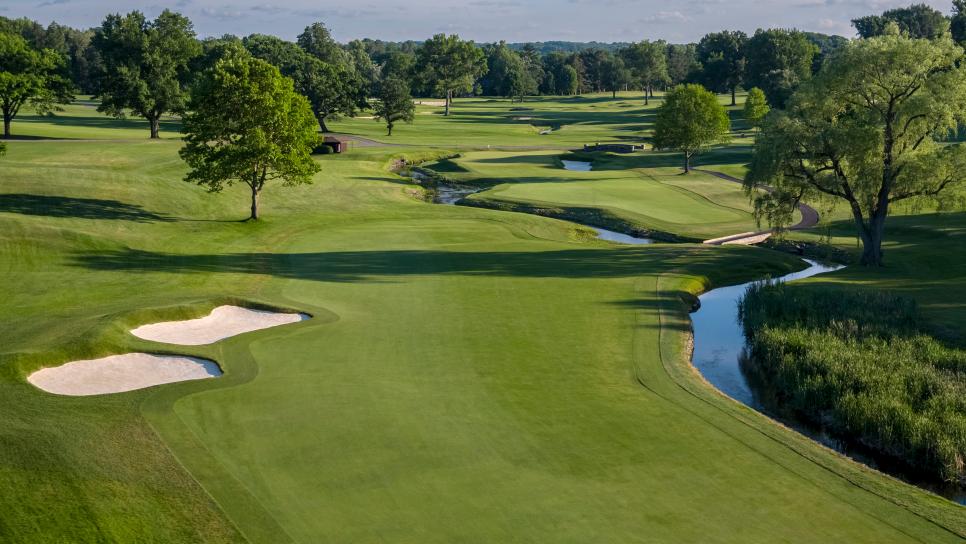Past major championships played at Oak Hill’s famed East Course—including the 1956, 1968 and 1988 U.S. Opens, and the 1980, 2003 and 2013 PGA Championships—usually came down to who put the ball in the fairway most consistently. An unrelenting shotmaker’s course, Oak Hill forced players to shape the ball off the tee, often around limbs of trees overhanging the fairway.
A 2019 remodel by architect Andrew Green changed the complexion of the course through significant tree thinning and the radical reshaping of greens and bunkers. Carving drives through avenues of branches is no longer part of the equation. Though there may be more airspace above, Jeff Sluman, the 1988 PGA Champion and Rochester native who consulted with Green on the renovation, believes that Oak Hill remains one of the most demanding driving courses in major championship golf. The narrow fairways, deep rough and steep-faced bunkers that will often have players pitching out sideways continue to place an extreme premium on hitting fairways.

Green expansions also give PGA of America chief championship officer Kerry Haigh the option to tuck pins during the 2023 PGA Championship in places that weren’t available in the past. Those tight corners won’t be accessible to players hitting out of the rough. The course may look different this time around, but the design has found new ways to test the game’s best, and there are plenty of places to throw away strokes.
Here are eight of the most difficult shots at Oak Hill’s East Course.
The tee shot on the par-3 third
The par-3 third is similar to the fourth at Augusta National: Both are long par 3s modeled after the Eden hole at St. Andrews with bunkers short and a green tilted back to front. It plays from high point to high point and demands an all-carry mid- or long-iron to the putting surface since a cavernous bunker covers the right-third of the green, with another stepped in on the left. Hole locations in a newly expanded back left corner are particularly hard to get to, and a false front will send any ball that doesn’t carry far enough careening back down the fairway.
The drive on the par-4 sixth
Placing the drive in the fairway at the long sixth is essential if players want any chance of reaching the green in regulation, which is propped up over the bank of Allen Creek. The landing area is tight, bracketed by two deep bunkers on the left and the same creek that bows into the fairway on the right. Even good drives notched between the hazards face a second shot of up to 200 yards, but those who miss will be scrambling to get back into position.
The drive on the par-4 seventh
The tee shot at the seventh, the second of four stout par 4s closing out the first nine, presents a puzzle. Trees crowding the fairway on the left can catch drives to that side, forcing players to aim the right. That’s where Allen Creek enters the fairway 270 yards from the tee, cutting diagonally right-to-left. The choice is to play short of the water leaving a 190-yard shot into the green, or force a drive between the trees and the creek for a shorter, clear approach. Surgical precision is required either way.
The approach at the par-4 9th
Only the front of the green and flagstick are visible from the fairway at the long, dogleg right ninth. The putting surface, set atop the clubhouse ridge, is shaped like a tricorn hat and tilted back to front, and going for pins in the narrow corners where the targets taper is a sucker play, especially considering the bouncy, canted fairway rarely offers a level lie. The professionals will gladly take 4 here and move on.
The approach at the par-4 12th
Many of the greens at Oak Hill have a bail-out either short or to chipping areas off to one side, but the 12th is pure target golf. Drives that hit the speed slot on the left side of the fairway will roll down to a flat spot with an ideal angle for the approach, but it must be unerring. Severe bunkers are cut into the base of the green, and shots that carry too far will get tangled in the rough above the hole leaving chips to a rippling putting surface that runs away. There’s simply no good place to miss this deep narrow green.
The second shot at the par-5 13th
Modern equipment and carry distances make the second shot at this long par 5 more interesting. Historically a layup for position, players who drive it in the fairway will now attempt to go for the green from 285 to 300 yards out. The bunkers 85 yards short of the green won’t come into play but the two fronting the green should get plenty of action. Considering where to miss the newly expanded putting surface set in an amphitheater will be important because the swales, slopes and ridges that run through it bring misery to short-sided recoveries.
The drive on the par-4 17th
There’s no faking your way through the drive at this daunting par 4 that members play as a par 5. It requires nothing less than an uphill drive of at least 300 yards to make it to the crest of the hill before the fairway turns right toward the green. Oaks at the inside corner block out shots hit short or to the right, and long rough and a series of mounds await drives to the left, turning the 17th back into a three-shot hole. Long hitters like Jon Rahm and Scottie Scheffler who fade the ball have a distinct advantage here.
The approach at the par-4 18th
Encircled in rough, flanked by bunkers (three on the right and one on the left) and set 12 feet above a depression, the 18th is another don’t-miss green. Shaun Micheel made the approach look easy when he almost stuffed a 7-iron from 175 yards on the 72nd hole to clinch the 2003 PGA, but everyone else will be staring down a shot where nothing less than perfection will suffice. Bunkers on the inside corner lengthen the shot by forcing drives out to the left, and it’s the finest of lines between carrying the ball onto the putting surface and remaining below the hole, or hitting past it and facing unstoppable downhill putts.
Here's our full drone tour with expert commentary on the changes at Oak Hill's East Course:
Watch our exclusive drone tour
• • •
Explore Golf Digest's recently relaunched Places to Play community, where you can add star ratings and reviews for all the courses you play. We've collected tens of thousands of reviews from our course-ranking panelists to deliver a premium experience, which includes experts' opinions, bonus course photography and videos, plus much more. Check it out here!



